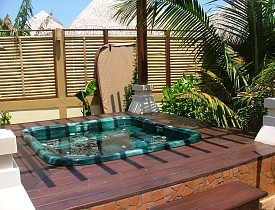How to Remove a Hot Tub
 Over the years as a Denver-area remodeling contractor, I have both installed and removed hot tubs. The removal process is not complicated, but still involves some planning. In most cases it is about half as much work as the installation. Many hot tubs are installed on decks, which are often built around the tubs. This can complicate matters but not as much as the engineering that may have gone into the deck's reinforcement or construction.
Over the years as a Denver-area remodeling contractor, I have both installed and removed hot tubs. The removal process is not complicated, but still involves some planning. In most cases it is about half as much work as the installation. Many hot tubs are installed on decks, which are often built around the tubs. This can complicate matters but not as much as the engineering that may have gone into the deck's reinforcement or construction.
Salvage or Disposal?
Before removing your hot tub, consider whether or not the tub is going to be reused or salvaged. Most tub removals are the result of a catastrophic maintenance or repair issue, usually not winterizing the tub. Bob Lauter, CEO of Master Spas and president of the International Hot Tub Association since 2012, warns: "If you're in a cool weather climate and you drain the hot tub and you don't winterize it, that's when you see water in the lines, because they didn't properly winterize it. You can have all kinds of frozen pipes...Residual water in the pipes can be in the pump housing. If that freezes it can damage the pumps. When we see a hot tub that's better off replacing it than fixing it, it's almost always due to freeze damage."
A 6-person hot tub is a pretty big item that generally requires many hands or lifting equipment to move. If the tub is DOA (Dead on Arrival), there are no worries about how it can be removed. I have seen units cut into manageable sized chunks with a reciprocating saw and hauled off in 50 to 100 pound sections. When it is obvious that a hot tub will never be used again, the ease of removing parts of the tub will require far less effort than getting it out in one piece.
Disconnect and Isolate
The majority of hot tubs are electric, some with high voltage connections. Address this electric service prior to any type of removal efforts. If the hot tub was installed to building codes, there should be a main electrical disconnect located close to the tub. If the tub is being removed entirely, and not replaced, the outlet feed from this box can be sealed and left available for a possible future re-install. Before servicing this smaller disconnect panel, shut down the power feed at the main panel. Once isolated, the circuit can be dismantled at the local disconnect and the lines terminated inside the smaller disconnect panel. As an added safety measure, keep the tub’s main breaker off and the circuit labeled “out of service.” Once isolated, the line from the disconnect panel to the tub's service panel can be safely removed. Needless to say, hire an electrician if you are not experienced.
Drain and Haul
The next step to removing a tub is to drain it. If the tub is destined for long term storage and reuse in a climate that sees freezing temperatures, add antifreeze to the piping and drain systems to prevent cracks and breaks due to frost. In the case of disposal, this step is not necessary.
Haulage methods vary widely, based on the tub's location and installation specifics. I have helped with some where the tub was merely tilted up on its side (with 4 burly piano-moving-type guys) and then rolled to a waiting trailer to be carted away. In another case, one was lassoed with a large tow strap and dragged through the yard with the winch on the front of my truck. This was a demolition job and is not recommended for any type of reuse! The “yard” was also expendable -- just some native ground cover that could be raked smooth. Dragging a full-sized tub across a manicured lawn would leave some serious skid marks.
In extreme circumstances, a crane may be required. If so, it is best to hire the services of a licensed rigger so the payload does not make any sudden trips to the ground. Keep in mind gravity always wins these tug-of-wars. Even with a hard hat…a falling hot tub could ruin your day.
Updated January 22, 2018.
Looking for a Pro? Call us (866) 441-6648

Plumbing Average Costs
Plumbers Experiences

Gas Line Installation Made Simple

Toilet Repair By A Plumber I Knew Was The Right One For Us



